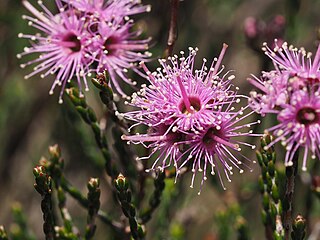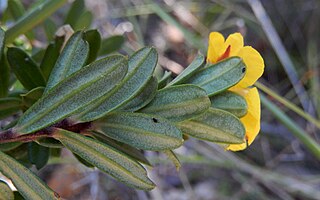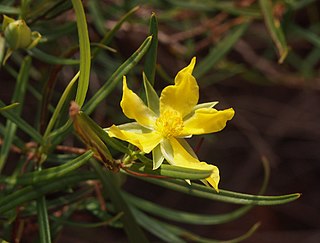
Hibbertia ericifolia is a species of flowering plant in the family Dilleniaceae and is endemic to south-eastern Australia. It is small, sometimes low-lying to spreading shrub with wiry stems, linear to narrow elliptic leaves, and yellow flowers arranged on the ends of branchlets, with ten to twenty-four stamens arranged around the three carpels.

Kunzea opposita is a plant in the myrtle family, Myrtaceae and is endemic to eastern Australia. It is a spindly shrub which has small leaves arranged in opposite pairs, and pink flowers with five petals and many stamens, the stamens much longer than the petals. It usually grows in woodland or on exposed cliffs.

Hibbertia bracteata is a species of flowering plant, in the family Dilleniaceae, and is endemic to eastern New South Wales. It is a shrub with lance-shaped to oblong leaves and yellow flowers with about sixteen stamens arranged on one side of the two carpels.

Hibbertia acicularis, commonly known as prickly guinea-flower, is a species of flowering plant in the family Dilleniaceae and is endemic to eastern Australia. It is an erect or prostrate shrub with linear to lance-shaped leaves and yellow flowers arranged singly in leaf axils with the six to eight stamens joined at the base, in a single cluster.
Hibbertia alopecota is a species of flowering plant in the family Dilleniaceae and is endemic to the Northern Territory. It is a low shrub with elliptic to lance-shaped leaves and yellow flowers arranged singly in leaf axils, with sixteen to twenty-four stamens arranged in bundles around two carpels.
Hibbertia angulata is a species of flowering plant in the family Dilleniaceae and is endemic to a restricted area in the Northern Territory. It is an erect sub-shrub with sessile, linear leaves and yellow flowers arranged singly in leaf axils, with seventeen to nineteen stamens arranged in bundles around the three carpels.
Hibbertia argyrochiton is a species of flowering plant in the family Dilleniaceae and is endemic to northern parts of the Northern Territory. It is a shrub densely covered with scales and has elliptic to lance-shaped leaves, and yellow flowers usually arranged singly in leaf axils, with twenty to twenty-four stamens arranged in groups around the two carpels.
Hibbertia arnhemica is a species of flowering plant in the family Dilleniaceae and is endemic to Arnhem Land in the Northern Territory. It is an erect shrub with hairy branchlets, egg-shaped or elliptic leaves and spikes of eight to fifteen yellow flowers, each with twenty to thirty stamens arranged on one side of the two carpels.
Hibbertia brennanii is a species of flowering plant in the family Dilleniaceae and is endemic to the Arnhem Land escarpment. It is a low, spreading sub-shrub with hairy foliage, elliptic to lance-shaped leaves and pale yellow flowers arranged singly in leaf axils, with ten to twelve stamens arranged in groups around the two carpels.
Hibbertia brevipedunculata is a species of flowering plant in the family Dilleniaceae and is endemic to northern Australia. It is a sub-shrub with hairy foliage, linear to lance-shaped leaves with the narrow end towards the base, and yellow flowers arranged singly on the ends of branches or short side shoots, with thirty to forty-four stamens arranged in bundles around the two carpels.
Hibbertia cactifolia is a species of flowering plant in the family Dilleniaceae and is endemic to the Arnhem Land escarpment. It is a multi-stemmed shrublet with hairy foliage, oblong to elliptic leaves and yellow flowers arranged singly in leaf axils, with twenty-six to twenty-eight stamens arranged in groups around the two carpels.
Hibbertia caudice is a species of flowering plant in the family Dilleniaceae and is endemic to northern Australia. It is a shrub with wiry stems, hairy foliage, elliptic to lance-shaped leaves with the narrower end towards the base, and yellow flowers arranged in leaf axils, mostly with twenty-four to twenty-six stamens arranged in groups around the two carpels.
Hibbertia ciliolata is a species of flowering plant in the family Dilleniaceae and is endemic to the northern part of the Northern Territory. It is a shrub with a single stem, hairy foliage, linear to elliptic leaves, and yellow flowers arranged in leaf axils, mostly with eighteen to twenty-six stamens arranged in groups around the two carpels.
Hibbertia cistifolia is a species of flowering plant in the family Dilleniaceae and is endemic to northern Australia. It is a prostrate to low-lying sub-shrub with trailing, wiry stems, hairy foliage, oblong to elliptic leaves and yellow flowers arranged in leaf axils, with forty to fifty-eight stamens arranged around the two carpels.

Hibbertia desmophylla is a species of flowering plant in the family Dilleniaceae and is endemic to the south-west of Western Australia. It is a sprawling or erect, hairy shrub with spreading, densely clustered, linear leaves and yellow flowers with eleven to thirteen stamens.
Hibbertia echiifolia is a species of flowering plant in the family Dilleniaceae and is endemic to northern Australia. It is a variable shrub with elliptic to lance-shaped or oblong leaves and yellow flowers arranged singly in leaf axils, with twenty-nine to forty-five stamens arranged around the three carpels.
Hibbertia extrorsa is a species of flowering plant in the family Dilleniaceae and is endemic to a restricted part of the Northern Territory. It is a small, spreading shrub with hairy foliage, linear to elliptic leaves, and yellow flowers arranged in leaf axils with about thirty stamens arranged in groups around the two carpels.
Hibbertia furfuracea is a species of flowering plant in the family Dilleniaceae and is endemic to near-coastal areas of south-western Western Australia. It is an erect shrub with narrow egg-shaped leaves with the narrower end towards the base, and yellow flowers borne in upper leaf axils, with ten to twelve stamens all on one side of two carpels.

Hibbertia glaberrima is a species of flowering plant in the family Dilleniaceae and is endemic to Central Australia. It is a glabrous, spreading shrub with oblong to lance-shaped leaves and yellow flowers borne singly in upper leaf axils, with 30 to 150 stamens arranged around three carpels.

Hibbertia glomerosa is a species of flowering plant in the family Dilleniaceae and is endemic to the south-west of Western Australia. It is a shrub with linear to narrow oblong leaves and bright yellow flowers borne on the ends of short side shoots, with twenty-five to thirty-eight stamens arranged in groups of five around the five glabrous carpels.






